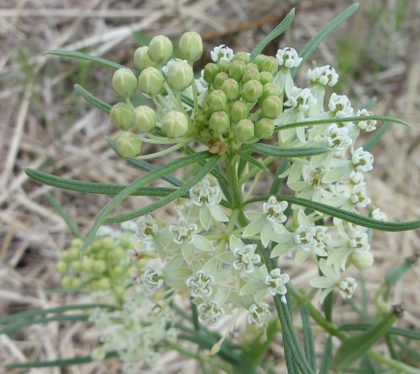Most people are aware of the value of milkweed as a host plant, to one of our favorite pollinators, the Monarch butterfly. A few of you are aware of its use as the fluff in comforters and coats. But did you realize there are 17 species of milkweed native to Nebraska, some of which are perfectly well-behaved companions in a landscape? What follows are photos, descriptions and comparisons of the 9 we see most often in Eastern Nebraska. Then a short description of the other species and their native range in Nebraska

Asclepias incarnata (swamp or rose milkweed) is the tallest and one of the best behaved, as is

Spider milkweed which is the shortest.
Spider milkweed is the earliest bloomer and as such is a valuable early season food source for bumblebees.
Asclepias speciosa (showy milkweed), A. syriaca (common milkweed) and A. sullivantii (sullivant’s milkweed) are all very similar in appearance.
 Showy milkweed holds its blossoms upright and they appear star-like and dusty pink.
Showy milkweed holds its blossoms upright and they appear star-like and dusty pink.
 The flowers of common milkweed also droop and are a dusty pink color.
The flowers of common milkweed also droop and are a dusty pink color.
 Sullivant’s milkweed also holds its flowers upright.
Sullivant’s milkweed also holds its flowers upright.
They are a bright pink and the leaves are smooth unlike common milkweed, which has fine hair like fur on the leaves. All three of these milkweed species spread by rhizomes as well as by seed.

Asclepias stenophylla (narrow-leaf milkweed) and

Green milkweed has wider leaves and greenish blossoms.
Below is a chart comparing the nine. From my experience, you can fearlessly plant Swamp, butterfly, spider, green and narrow-leaf milkweed in your yard without worry. Common and Showy milkweed are best left to wide open spaces. Sullivant’s milkweed will spread by rhizomes and so if you want to keep it out of your lawn, best to leave it in a larger planting of prairie, although it is not as intrusive and common or showy milkweed. Whorled milkweed will spread within a few feet in a couple of years, but the plant remains diminutive and is still a good choice for a wildflower planting or pollinator patch.
| Name | Color | Height | Spreads or Not |
| Swamp mw | Rose | 6 feet | Some seed spread |
| Showy mw | Pink | 4 | Prolific seeder and spreader |
| Narrow-leaf mw | White | 2 | Mostly rhizomes |
| Sullivant’s mw | Bright Pink | 3 | Rhizomes |
| Common mw | Dusty Pink | 4 | Prolific seeder and spreader |
| Butterfly mw | Orange | 3 | Tuberous some seeding |
| Whorled mw | White | 3 | Mostly rhizomes |
| Green mw | Green/white | 1.5 | Slow spreader with seed |
| Spider mw | Green/purple | 1 | Some seed spread |
Other milkweed species native to Nebraska are as follows
Asclepias amplexicaulis (bluntleaf milkweed or clasping milkweed). The base of the leaves wraps the stem. This species is native to the Missouri River counties and to Jefferson County in Nebraska. It is similar to Mead’s milkweed, which may be present in Nebraska, but has not been collected here. It has green flowers while clasping milkweed has pink flowers.
Asclepias arenaria (sand milkweed). Shortish, native to the sandhills and surrounding counties. Greenish flowers.
Asclepias asperula (antelope horn), from Nuckoll’s County in Nebraska. Similar in color and stature to Spider milkweed, but with narrower leaves.
Asclepias engelmanniana (Engelmann’s milkweed) native to the far western and southwestern counties in Nebraksa. This species is similar to narrow-leaf milkweed but more stout.
Asclepias lanuginosa (wooly milkweed), scattered throughout central Nebraska. It is similar to green milkweed but is covered in fine hairs.
Asclepias latifolia ( broadleaf milkweed) is found in the SW counties in Nebraska. Its flowers resemble spider milkweed and are found in the axils of very large broad leaves ringing the stem.
Asclepias pumila (Plains milkweed or dwarf milkweed) can be confused with whorled milkweed, but dwarf milkweed has flowers with a pinkish tinge and branches at the base. It is found in the wester 2/3 of Nebraska counties.
Asclepias purpurascens (purple milkweed) has been found only in Nemaha and Richardson Counties. Flowers of this species are a deep rose to magenta. It is similar in stature to Sullivan’s milkweed.

